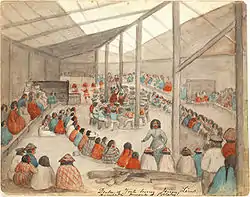
Watercolor by Swan depicting the Klallam people of Port Townsend, with one of chief Chetzemoka's wives distributing potlatch.

Portrait of James G. Swan, 1883
James Gilchrist Swan (January 11, 1818 – May 18, 1900) was an American Indian agent in what is now the U.S. state of Washington, who was known as an authority on the indigenous peoples of the Pacific Northwest Coast, an Indian artifact collector on behalf of the Smithsonian Institution, and for writing the first ethnography of the Makah tribal group, among whom he lived.
A curious and creative man, his imaginative ambitions included a fantasy of making paper from Puget Sound seaweed.[1]
Sources
- Doig, Ivan (1980) Winter Brothers: A Season at the Edge of America. New York: Harcourt Brace Jovanovich.
- McDonald, Lucile (1972) Swan among the Indians: Life of James G. Swan, 1818–1900. Portland, Oregon: Binfords and Mort.
References
- ↑ Geocaching. "Historic Laurel Grove Cemetery Tour". Retrieved 2018-08-13.
Writings
- Swan, James Gilchrist (1870). The Indians of Cape Flattery : at the entrance to the Strait of Fuca, Washington Territory (DJVU). Smithsonian Institution. OCLC 3602788.
- Swan, James Gilchrist (1857). The Northwest coast, or, Three years' residence in Washington Territory (DJVU). Harper. OCLC 55630405.
External links
- "Swan, James G. (1818–1900)". By Kit Oldham. HistoryLink.org. January 9, 2003.
- James G. Swan at Find a Grave
- "James Gilchrist Swan", University of Washington Libraries
This article is issued from Wikipedia. The text is licensed under Creative Commons - Attribution - Sharealike. Additional terms may apply for the media files.